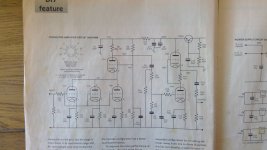Many years ago I built an RIAA preamp by " world audio design " using 6 valves all 6922's 3 per channel. It still plays OK until it gets a large voltage swing when I lower or raise the needle then it starts motorboating. I have heard this could be coming from the power supply which is valve rectified and regulated by the " Lite LS9D " kit. Anybody back this up or is it more likely coming from the preamp itself ?
If you could post a schematic, folk here could give a better response, but in general, that's a lot of valves, even for a phono stage, so a lot of potential gain. Lotsa gain means lotsa opportunity to feed back through the power supply. Two (conventional) gain stages feed back negatively, so stable. Three stages feed back positively, last stage to first, so unstable. Hence, rayma's recommendation for more first stage decoupling.
Some tyro designs seem intent on playing all the record's warps and subsonic noise, so correcting that might help, and improve the sound. Can't say; haven't seen the schematic.
All good fortune,
Chris
Some tyro designs seem intent on playing all the record's warps and subsonic noise, so correcting that might help, and improve the sound. Can't say; haven't seen the schematic.
All good fortune,
Chris
Member
Joined 2009
Paid Member
Blocking distortion is another one to check (with schematic) since it seems that it’s triggered by a large signal.
This may be it. Try more supply capacitance, 100uF or so.
If that does not help, also reduce the first coupling capacitor to ~33nF, or even 10nF if it works.
If that does not help, also reduce the first coupling capacitor to ~33nF, or even 10nF if it works.
Attachments
Last edited:
If the supply is really regulated, it is unlikely to be the cause. Is there a circuit for this 'Lite LS9D' kit?Many years ago I built an RIAA preamp by " world audio design " using 6 valves all 6922's 3 per channel. It still plays OK until it gets a large voltage swing when I lower or raise the needle then it starts motorboating. I have heard this could be coming from the power supply which is valve rectified and regulated by the " Lite LS9D " kit. Anybody back this up or is it more likely coming from the preamp itself ?
Jan
So it's not a regulator, just an emitter follower. That will have some output impedance, but probably not high enough to cause motorboating.
Next suspect would be several high passes in the amp like coupling cap-soure/load resistance that have a similar RC time so to cause steeper roll/offs with the faster phase shifts causing feedback that manifests itself as motorboating.
Edit - missed that, waiting for psu.
Jan
Next suspect would be several high passes in the amp like coupling cap-soure/load resistance that have a similar RC time so to cause steeper roll/offs with the faster phase shifts causing feedback that manifests itself as motorboating.
Edit - missed that, waiting for psu.
Jan
Maybe your electrolytics have dried up a bit. Try putting some new caps across the old ones on the decoupling caps on the input stages.
A logical thing to do would be to measure the supply input voltage and output voltage, to see if there's enough headroom.
If there is (say 50V or more), load the output down with a resistor that draws say 20mA and see if and how much the output drops.
That would at least give some information that it works as it should. Or not.
If it drops too much or if there is not enough headroom, set it to a lower output until it does work.
Jan
If there is (say 50V or more), load the output down with a resistor that draws say 20mA and see if and how much the output drops.
That would at least give some information that it works as it should. Or not.
If it drops too much or if there is not enough headroom, set it to a lower output until it does work.
Jan
- Home
- Amplifiers
- Tubes / Valves
- Motorboating preamp


